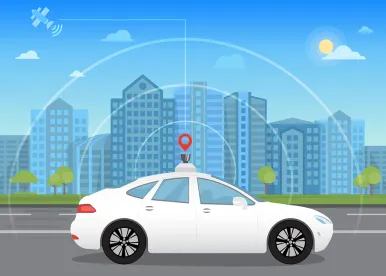I. Introduction
Recent developments in automated vehicle technologies have generated great excitement from multiple segments of American society, including the automotive and trucking industries, federal, state, and local government, and the general public. The development of “self-driving” or “automated driving systems” (ADS) has the potential to drastically alter the way our society perceives a broad range of concepts—from transportation and mobility to infrastructure to urban spaces to human-machine interaction. Although automated vehicle technology is still at a fairly nascent stage of deployment, the underlying technology is rapidly developing. In response, federal, state and local governments have already undertaken efforts to develop regulatory approaches to facilitate and encourage ADS innovation while ensuring the safety and security of end users.
On the federal side, both the legislative and executive branches have taken several recent and notable steps toward the governance of automated vehicles. Earlier this month the House of Representatives—in a rare moment of bipartisanship—passed H.R. 3388, the “SELF DRIVE Act,” which sets forth a regulatory framework for passenger vehicles. Not to be outdone, the Senate Commerce, Science, and Transportation Committee is drafting its own bill and last week held a hearing entitled “Transportation Innovation: Automated Trucks and our Nation's Highways” to explore the policy opportunities and impacts on the labor force from automated heavy-duty vehicles (which are defined as any vehicle weighing over 10,000 pounds).
Also last week, Elaine Chao, Secretary of Transportation unveiled a new National Highway Transportation Safety Administration (NHTSA) guidance document entitled, “Automated Driving Safety (ADS): A Vision For Safety 2.0” (ADS Guidance). The ADS Guidance, which replaces prior guidance published by the Obama Administration in September 2016, is intended to provide industry, states, and other stakeholders with recommended best practices and other considerations related to the testing and deployment of ADS systems.
This alert outlines recent federal activity related to automated vehicles, with particular focus on the revised ADS Guidelines. Section II provides a “State of Play” for vehicle manufacturers and technology developers seeking to enter the ADS space. Section III provides a brief overview of recent federal activity—both from Congress and the executive branch—on automated vehicles. Section IV highlights several critical legal and policy considerations that automated vehicle developers, states, and the general public should contemplate as NHTSA seeks to implement and refine the ADS Guidance. A high-level summary of the ADS Guidance is provided as an Appendix.
II. State of Play
Today, entities seeking to imminently test and deploy automated vehicles in the United States are confronted with a complicated regulatory landscape created by federal inaction and a patchwork of individual state policies. Traditionally, the federal government has claimed the role of setting motor vehicle safety standards while the states are left to regulate licensing, vehicle registration, inspections, insurance, and the like. However, federal guidance on automated vehicle technology to this point has been voluntary in nature, leaving a regulatory void that states have moved quickly to fill. Currently, 25 states have adopted their own legislation or regulations on automated vehicles, resulting in a patchwork of state regulations that make it difficult for developers to innovate, test and sell their technologies across the country. Contiguous states, for example, may have different regulations that prevent an automated vehicle from crossing state lines, which can substantially delay the deployment of these technologies into interstate commerce.
While some states are taking regulatory action, vehicle manufacturers have also taken steps to coordinate information sharing and preventative measures to overcome a vacuum of regulatory certainty. For instance, vehicle manufacturers are seeking to provide input through standards organizations like the Automotive Information Sharing and Analysis Center (Auto-ISAC). The Auto-ISAC was formed in August 2015 to establish a global information sharing community, with membership open to light-and heavy-duty vehicle original equipment manufacturers (OEMs) and vehicle suppliers, along with commercial vehicle companies. The guidance issued by NHTSA last week encourages entities to utilize the Auto-ISAC and similar organizations to share information on cyber threats and vulnerabilities, crash data, consumer reporting and more related to automated vehicles. However, this guidance remains voluntary.
For these reasons, both the Department of Transportation and the Congress are taking action on this issue to provide certainty as to the near- and long-term regulatory climate for these technologies.
III. Overview of Recent Federal Activity on Automated Vehicles
For the last several years, the federal government has recognized that automated vehicles stand to play a significant role in the future of mobility in the United States, with the possibility of dramatically increasing safety on America’s roadways. The federal government has also acknowledged that myriad factors—including public trust in ADS systems and the complex interfacing of federal and state regulations—will influence the speed and success with which automated vehicle technology progresses in this country. Accordingly, the last two presidential administrations have sought to minimize potential impediments to automated vehicle deployment by publishing voluntary guidelines for developers and regulators.
Secretary Chao’s announcement of the ADS Guidance at an event in Ann Arbor, Michigan on September 12, 2017, marks the first official action by the Administration of President Donald Trump to articulate its vision for the future of automated vehicle technology. Publication of this policy comes at a time of heightened focus on the issue of automated vehicles—with at least three noteworthy events occurring in the past month.
First, on September 8, 2017, the House of Representatives passed the SELF DRIVE Act with a rare bipartisan voice vote. Among other requirements, the SELF DRIVE Act (i) requires NHTSA to promulgate regulations governing automated vehicle safety assessment processes; (ii) mandates that vehicle manufacturers develop plans to address cybersecurity and privacy risks associated with ADS; (iii) preempts state regulation of automated vehicle technologies; and (iv) creates exemptions to some Federal Motor Vehicle Safety Standards (FMVSS) for testing of such vehicles and technologies.
Second, on September 13, 2017, the Senate Commerce, Science and Transportation Committee held a hearing entitled “Transportation Innovation: Automated Trucks and our Nation’s Highways”. The hearing follows ongoing negotiations between the Committee’s Republicans and Democrats on the final details of their own automated vehicle bill, the “AV START Act.” As currently drafted, the AV START Act provides a similar framework to the SELF DRIVE Act but also includes the regulation of heavy-duty trucks, though the applicability remains an issue to be decided by the Committee. Notably, some Senate Democrats have articulated concern that the additional safety benefits and efficiencies rendered by widespread deployment of automated commercial vehicles will not outweigh safety concerns and the economic impacts on American workers.
Third, on September 12, 2017, the National Transportation Safety Board (NTSB) asserted that Tesla should bear some blame for the May 2016 death of an individual driving one of the company’s Model S vehicles, concluding that the company should have better educated drivers of its cars about the limitations of its driver assistance technologies.
These recent events reveal a federal government in the early stages of working through the immense policy and regulatory challenges that are sure to arise with widespread ADS deployment. Further, these events demonstrate that there is no clear consensus among elected officials and policymakers with respect to most effective and equitable mechanisms to balance the needs to foster innovation, to ensure public safety, and to minimize and/or abate the economic impacts on American workers. Ultimately, the debate over the best ways to address these concerns is sure to intensify as this disruptive technology becomes more widespread.
IV. Considerations for Automated Vehicle Developers, Regulators, and the General Public
While the ADS Guidance does not create any new legal obligations for ADS developers, publication of the document is significant in that it marks the second time in twelve months that a presidential administration has issued a vision on the future of automated vehicle technology in the United States. Now that automated vehicle technology is more visible politically, there is an increased likelihood that the regulatory and legal landscapes may take unexpected turns that could either stifle or bolster future innovation.
At this time, the ADS Guidance is merely non-binding policy and does not create any new rights or obligations, which is both a benefit and a drawback for the ADS industry. On the one hand, the lack of definitive regulations guiding the development of automated vehicle systems allows industry greater flexibility to innovate without creating regulatory roadblocks that are outdated as quickly as they are published. As has been observed in the unmanned aerial vehicle (or “drone”) context, regulations issued by the Federal Aviation Administration were effectively obsolete the moment they were finalized, creating difficulty for various entities seeking to utilize drones to fully realize the potential of the technology.
On the other hand, the absence of federal regulation could expose the automated vehicle space to the impacts of shifting public and political opinion. For example, if automated vehicle use were to result in injury, death, and/or some other type of safety incident, then public opinion could pressure a presidential administration to implement safety reforms through Administrative Procedure Act rulemaking. Rulemaking could limit significantly the ability of ADS developers to test and deploy new technologies at a pace sufficient to keep up with competition from entities operating in other countries. Federal rulemaking could potentially lead to conflicts of laws with state regulators, many of whom have moved to address what they perceive as safety concerns brought about by this new technology. An additional layer of federal requirements could further complicate matters if not carefully crafted.
As noted above, Congress is already taking action to provide federal preemption under certain circumstances, with some key issues to be resolved. The SELF DRIVE Act, which the House passed earlier this month, would apply only to passenger vehicles and not to commercial trucks, in contrast to the ADS Guidance. By excluding commercial trucks from the potential regulatory scheme, the House bill would unnecessarily create obstacles to the development and incremental deployment of ADS technology in trucks that may allow for safer, more efficient operation. As noted above, the Senate Commerce Committee is considering its own automated vehicle legislation, and whether commercial trucks will be covered is not yet clear.
With respect to the particulars of the ADS Guidance, it is notable that the policy is concerned with documenting and establishing an internal record of efforts to manage risk. Properly documenting these types of risk should be the first and most important step in an entity’s crisis management efforts and could prove invaluable in the event of an investigation or lawsuit arising out of a crash or other incident.
It is also notable that the ADS Guidance neither addresses privacy or ethical concerns nor requires specific actions to ensure cybersecurity protections. Although documented compliance with industry standards, state and federal laws, and the twelve priority elements outlined in the ADS Guidance may create a presumption that could protect manufacturers from liability, addressing the full scope of legal risks and liabilities associated with automated vehicle technologies may require greater specificity and enforceability. Going forward, it will be challenging for legislators and regulators to create a rubric that engenders innovation and technological evolution while simultaneously ensuring adequate legal safeguards to protect drivers, individuals, and automated vehicle developers.
Appendix: Summary of the Revised NHTSA Automated Vehicle Guidelines
The Trump Administration, like the Obama Administration before it, clearly recognizes the potential of self-driving technology to promote safer and more efficient transportation, including a significant reduction in traffic fatalities due to human error. Accordingly, NHTSA has published the ADS Guidance in order to provide a policy framework for the safe development and deployment of automated vehicles.
The ADS Guidance applies to the design aspects of motor vehicles and motor vehicle equipment under NHTSA’s jurisdiction; it does not apply to vehicle operations that would otherwise be regulated by another federal or state entity. Further, the policy is specifically focused on vehicles that incorporate one of three levels of enhanced automation—conditional automation, high automation, or full automation (SAE International Automation Levels 3 through 5). The ADS Guidance document consists of two non-enforceable, non-binding sections, each of which sets forth a litany of suggested best practices and practical considerations for successful—and safe—deployment of automated vehicles. Section 1, entitled “Voluntary Guidance for Automated Driving Systems,” is targeted at those entities in the ADS development space. Section 2, “Technical Assistance to States, Best Practices for Legislatures Regarding Automated Driving Systems,” is aimed at state legislatures and safety regulators.
Ultimately, the Administration hopes that this “non-regulatory approach” will help encourage new entrants to move into the ADS space and facilitate design concepts and other ideas that will result in safer vehicles. At the same time, the policy seeks to help automated vehicle developers preserve public trust by encouraging ADS participants to disclose their individual efforts to comply with the ADS Guidance. Further, the Administration hopes that by framing this document as voluntary guidance, rather than by pursing notice and comment rulemaking, it can foster a flexible quasi-regulatory DOT process that can more ably respond to the rapid rate of change and innovation in the private sector. To facilitate further public participation and trust in this quasi-regulatory process, NHTSA is inviting the public to comment on the ADS Guidance. Comments are due by November 14, 2017. Additionally, NHTSA states that it will periodically update the ADS Guidance “to reflect advances in technology, increased presence of ADSs on public roadways, and any regulatory or statutory changes that occur at both the Federal and State levels.” Secretary Chao said last week that NHTSA is already planning for a new update to the guidance in 2018.
a. Voluntary Guidance for Automated Driving Systems
Consistent with NHTSA’s statutory mandate to “protect the safety of the driving public against unreasonable risks of harm that may arise because of the design, construction, or performance of a motor vehicle or motor vehicle equipment, and to mitigate risks of harm,” section 1 of the ADS Guidance is appropriately aimed at automated vehicle designers to help those entities “analyze, identify, and resolve safety consideration prior to deployment using their own industry and other best practices.”
Section 1 outlines twelve priority safety design elements for consideration by automated vehicle developers. According to NHTSA, these twelve elements constitute “the most salient design aspects to consider and address when developing, testing, and deploying ADSs on public roadways”:
-
System Safety
-
Operational Design Domain (ODD)
-
Object and Event Detection and Response (OEDR)
-
Fallback (Minimal Risk Condition)
-
Validation Methods
-
Human Machine Interface
-
Vehicle Cybersecurity
-
Crashworthiness
-
Post-Crash ADS Behavior
-
Data Recording
-
Consumer Education and Training
-
Federal, State, and Local Laws
NHTSA encourages all ADS developers to internally document how they have chosen to incorporate the twelve elements into their development and testing processes. Further, NHTSA encourages ADS developers to also publish a “Voluntary Safety Self-Assessment,” which is a public document disclosing how a particular entity has (i) considered the safety aspects of automated vehicle systems; (ii) communicated and collaborated with the Department of Transportation; (iii) encouraged the self-establishment of industry safety norms for automated vehicles; and (iv) fostered public trust, acceptance, and confidence through transparent testing and deployment of automated vehicles.
b. Technical Assistance to States
Recognizing that states are eager to both reap the benefits and manage the risks of automated vehicle deployment on their roadways, section 2 serves to clarify and delineate the role of federal and state entities in regulating automated vehicles. Additionally, section 2 provides suggested best practices for state legislatures and regulators. The objective of this section is not to create uniform laws and policies across states; rather, the intent of section 2 is to proactively articulate proper legal authorities in an effort to minimize the potential for conflicts of law and to flag areas where state law might create unintended impediments to ADS deployment.
With respect to the delineation of federal/state authority, the ADS Guidance makes clear that NHTSA possesses sole authority to regulate safety design and performance aspects of motor vehicles and motor vehicle equipment. States, meanwhile, are vested with regulatory authority over human drivers and vehicle operations.
The best practices portion of section 2 recommends that state legislatures provide a “technology neutral” environment that does not unnecessarily burden competition and innovation. The intent of this recommendation is to ensure that states do not limit ADS market participants to only those entities currently operating in the motor vehicle manufacturing space. State legislatures are also encouraged to review traffic laws and regulations to identify and remedy potential provisions that may serve as a barrier to automated vehicle operation. As an example, NHTSA notes that state laws requiring a human operator to have one hand on the steering wheel at all times would prohibit deployment of Level 3 through 5 ADS technology.[1] The ADS Guidance further recommends that state legislatures develop licensing and registration procedures for ADS entities and operators as well as provide reporting and communications mechanisms to facilitate better coordination between ADS developers and public safety officials in the event of crashes and other incidents involving automated vehicles.
Section 2 also outlines best practices for state highway safety officials related to traditional areas of their authority, including administrative functions, the review and approval of applications for testing on public roadways, and liability and insurance. In particular, issues surrounding liability raise fascinating—and extremely difficult—legal questions, including how to appropriately allocate liability among ADS owners, operators, passengers, manufacturers, and other entities when a crash occurs, as well as how to allocate tort liability. As ADS systems develop toward full automation—and the artificial intelligence inherent in those systems becomes more sophisticated—states likely will have to rethink traditional concepts of liability to account for rapid developments in machine learning.
[1] For example, section 1226 of the New York Vehicle and Traffic Law may impede deployment of automated vehicles in New York because it states that “no person shall operate a motor vehicle without having at least one hand . . . on the steering mechanism at all times.”






 />i
/>i
